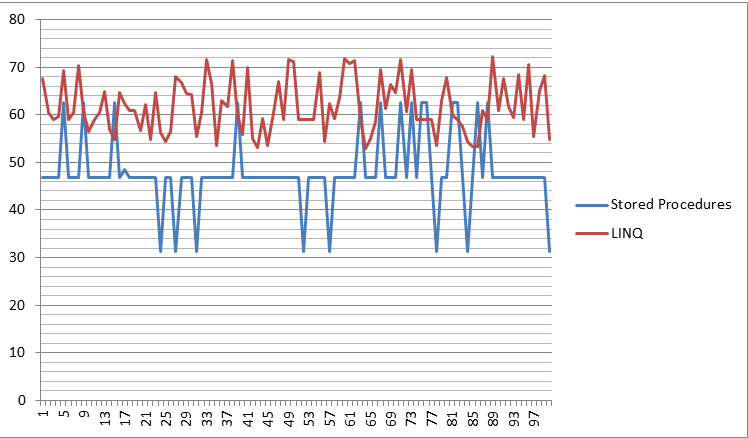SQL Server stored procedures and LINQ: A comparison
Introduction (LINQ and SQL Server stored procedures):
SQL Server’s stored procedures have been around for quite a while. By providing a compiled block of SQL on the server, ready to be called whenever needed, stored procedures have arguably been an irreplaceable tool for both software developers and database administrators alike, limiting the room for error and improving the server’s response time.
The introduction of LINQ as part of the .NET 3.0 Framework along with a set of libraries and seamless integration with Visual Studio, split software developers into two camps: one camp that favours stored procedure and a second camp that favours LINQ. Today, it is not uncommon for these two technologies to complement each other during the software development phase. This article attempts to shed a light on the advantages of these two technologies and includes an experiment that measures their response times.
The Advantages of using LINQ over Stored Procedures (LINQ vs Stored procedures)
1.- Visual Studio Integration
Being part of the .NET framework means that LINQ is seamlessly integrated into Visual studio. This means that all Visual Studio language features, add-ons and tools such as type declaration and casting, loop and logical constructs, debugging and testing are available to the developer all in one place. Most database vendors don’t offer these features (especially debugging) as part of their database management system package. It is also worth to note that SQL knowledge (to some extent) is not needed to be able to use LINQ effectively. However, SQL knowledge is a plus since the LINQ syntax is very similar to the T-SQL syntax.
2.- Entities
With LINQ creating objects from database tables is a fairly easy practice. All database relationships, stored procedures and functions are translated into objects and functions which give the developer a better platform to write a simple and cleaner code.
3.- Parallel LINQ or PLINQ:
Is another important and useful feature of LINQ. PLINQ is a query execution engine that accepts LINQ-to-Objects or LINQ-to-XML queries and automatically manages the load balance across multiple processors without the need to learn any of the load balancing methods and technologies. This obviously allows for better scalability.
4.- DBMS Independence:
LINQ works seamlessly across a range of database management systems which gives it a huge advantage over stored procedures which are not necessarily a part of every DBMS (especially compact and medium size DBMS).
The Advantages of using Stored Procedures over LINQ
1.- Response Time: since stored procedures are “native” to the database engine, this means that the query response time is shorter than that of when using LINQ. Also when using stored procedures only the stored procedure name and arguments are sent over to the server whereas LINQ serialises the entire query which can add a lot of overhead for more complex queries. To illustrate the difference in response / data retrieval time we created two similar queries, one using LINQ and the other using stored procedures and we executed them 100 times. The average execution time for the LINQ query was 61.66 milliseconds and the average execution time for the stored procedure query was 47.82 milliseconds meaning that the stored procedure execution time was on average 22.44% faster than LINQ execution time. Figure 1 provides a graphical interpretation of the result.
Figure 1. LINQ vs stored procedures Response Time
2.- Easier Code Updates: It is not uncommon for the database structure to change after the application had already been compiled and published. Provided that the stored procedure’s signature is unchanged, using stored procedures allows developers to make changes to the database code without the need to recompile the application, saving time and making database bug fixes considerably easier than changing the actual application code.
3.- Better Security: SQL Server is renowned for its security. Using stored procedures ensures that the bulk of the work is processed on the server side. In most cases, arguments are passed to the stored procedure from within the application code allowing programmers to keep their database schema and entities private if needed. LINQ generally exposes the database entities and their properties; whilst this is not necessarily a bad thing, it can be a concern when the database schema needs to be private
The Verdict
Whilst these two technologies are not comparable entities due to the fact that they use different platforms and call upon different design strategies, the end result is always the same, namely data extraction and/or manipulation. So which technology is better?
There isn’t a simple answer to this question. It is undeniable that coding stored procedures can be time consuming compared to coding in LINQ. However, they provide better flexibility, scalability, and security. On the other hand, LINQ can be used in conjunction with the coding language’s (C#, VB .NET, etc.) statements and syntax creating a powerful combination that can expedite the development process. Additionally, Visual Studio includes tools that transform the database schema into entities that can be altered from within the code, effectively providing programmers with a neat and easy to use graphical interface. Therefore, favouring one technology over another generally depends on the project requirements, size, and the developer’s preference. Sometimes, using a combination of these two technologies in your solution and taking advantage of their features can be a successful strategy.

